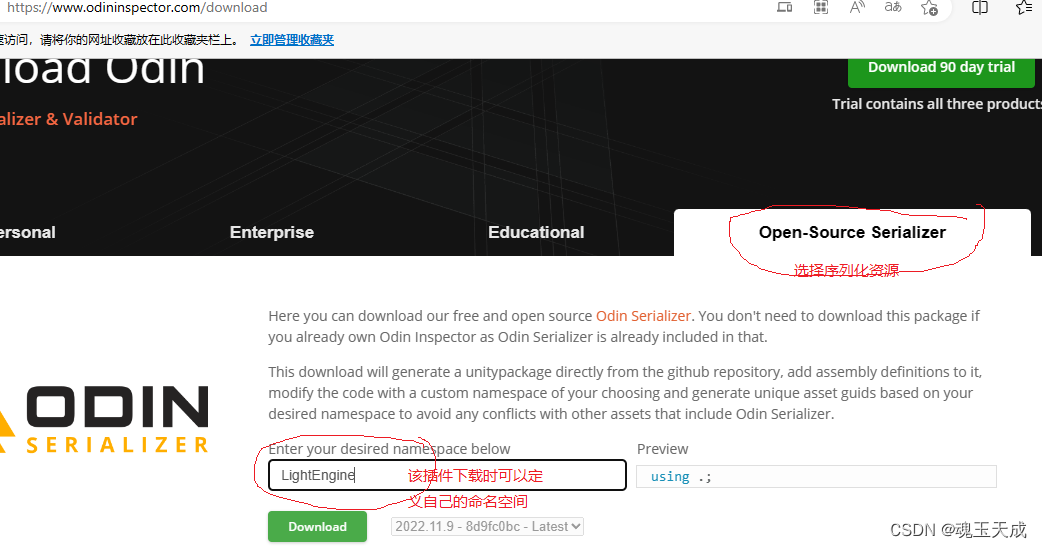unity 序列化那些事,支持Dictionary序列化

目录
一、普通类型和UnityEngine空间类型序列化
二、数组、list的序列化
三、自定义类的序列化支持
四、自定义asset
五、在inspector面板中支持Dictionary序列化
1、在MonoBehaviour中实现Dictionary序列化
2、自定义property,让其在inpsector能够显示
3、MonoBehaviour脚本中Dictionary字典的测试
4、asset中脚本对字典Dictionary的支持
1)下载OdinSerializer 序列化插件
2)定义序列化类
unity中的inspector面板支持list,但是有时候我们需要Dictionary,尤其是我们需要通过asset资源与ScriptableObject脚本一起实现序列化时更是需要如此。如:技能需要通过id来确定访问单个技能数据,那必须满足key和Value的数据结构。
由于unity并不是原生的支持对字典的序列化,这件简述了unity关于序列化与及自定义类的序列化的方法,同时实现在inspector面板中字典序列化问题,以及asset资产中实现序列化 Dictionary的方法。在实际运用中我们可以通过OdinSerializer 的的Serialize插件配合使用来实现我们我想要的效果。
一、普通类型和UnityEngine空间类型序列化
对于普通的MonoBehaviour对象常用public数据类型是支持直接序列化的,如果是namespace UnityEngine下的对象都可以被序列化

在inspector面板下,我们看到如果是基础类型和UnityEngine命名空间下类型,可以直接序列化。

二、数组、list的序列化
在实际过程中我们往往需要数组或列表序列化。unity对与能显示指定类型的容器可以序列化。对于Array容器因为其不知道它所定义的数据类型unity并没有提供直接支持,当然字典Dictionary无法直接支持。
定义一个list<int>链表和int[]的原始数值
![]()
inspector面板值

三、自定义类的序列化支持
我们有时并不满足只有基础类型的序列化,如果对自定义类进行序列化呢?这时候需要用到两个
attribute。在定义类的时候,需要Serializable和SerializeField配合使用。在定义类的时候添加Serializable属性,Serializable是作用类在,定义类成员变量时需要SerializeField,,SerializeField是作用字段
定义序列化类

看下面板值

我们前面讲过list和[]链表和数组类型的时候,基础类型是直接支持的,通过Serializable对类属性定义,并不需要SerializeField
如图:
定义自定义类容器
![]()
ipspector面板的显示值

四、自定义asset
我们想不依赖MonoBehaviour类做序列化,只是想做纯数据的的资源,比如技能数据或这角色数据等。unity通过ScriptableObject该类来我们提供了实现的方法。CreateAssetMenu提供给我们一个创建菜单的属性,menuName是菜单名,fileName是文件名称
using UnityEngine;
using System;[CreateAssetMenu(menuName = "Config/" + "技能数据", fileName = nameof(SkillData))]
public class SkillData : ScriptableObject
{public int id;public string name;public Effect effect;}[Serializable]
public class Effect
{public int type;public float beginTime;public float durationTime;
}
在 config/技能数据 下创建相对与SkillData类的asset.
操作步骤如下:Assets目录下找到你想要目录,点击右键,会弹出如下菜单:

创建出SkillData.asset资源

五、在inspector面板中支持Dictionary序列化
总体设计思路是通过list实现对Dictionary的支持,由于Unity的inpsector面板中并不直接支持字典,所以我们还需要自定义Property,通过CustomPropertyDrawer属性来实现
1、在MonoBehaviour中实现Dictionary序列化
定义SerializableDictionary类,并继承IDictionary接口,重写该IDictionary接口函数
using System;
using System.Collections;
using System.Collections.Generic;
using System.Linq;
using UnityEngine;public class SerializableDictionary { }[Serializable]
public class SerializableDictionary<TKey, TValue> :SerializableDictionary,ISerializationCallbackReceiver,IDictionary<TKey, TValue>
{[SerializeField] private List<SerializableKeyValuePair> list = new List<SerializableKeyValuePair>();[Serializable]private struct SerializableKeyValuePair{public TKey Key;public TValue Value;public SerializableKeyValuePair(TKey key, TValue value){Key = key;Value = value;}}private Dictionary<TKey, int> KeyPositions => _keyPositions.Value;private Lazy<Dictionary<TKey, int>> _keyPositions;public SerializableDictionary(){_keyPositions = new Lazy<Dictionary<TKey, int>>(MakeKeyPositions);}private Dictionary<TKey, int> MakeKeyPositions(){var dictionary = new Dictionary<TKey, int>(list.Count);for (var i = 0; i < list.Count; i++){dictionary[list[i].Key] = i;}return dictionary;}public void OnBeforeSerialize() { }public void OnAfterDeserialize(){_keyPositions = new Lazy<Dictionary<TKey, int>>(MakeKeyPositions);}#region IDictionary<TKey, TValue>public TValue this[TKey key]{get => list[KeyPositions[key]].Value;set{var pair = new SerializableKeyValuePair(key, value);if (KeyPositions.ContainsKey(key)){list[KeyPositions[key]] = pair;}else{KeyPositions[key] = list.Count;list.Add(pair);}}}public ICollection<TKey> Keys => list.Select(tuple => tuple.Key).ToArray();public ICollection<TValue> Values => list.Select(tuple => tuple.Value).ToArray();public void Add(TKey key, TValue value){if (KeyPositions.ContainsKey(key))throw new ArgumentException("An element with the same key already exists in the dictionary.");else{KeyPositions[key] = list.Count;list.Add(new SerializableKeyValuePair(key, value));}}public bool ContainsKey(TKey key) => KeyPositions.ContainsKey(key);public bool Remove(TKey key){if (KeyPositions.TryGetValue(key, out var index)){KeyPositions.Remove(key);list.RemoveAt(index);for (var i = index; i < list.Count; i++)KeyPositions[list[i].Key] = i;return true;}elsereturn false;}public bool TryGetValue(TKey key, out TValue value){if (KeyPositions.TryGetValue(key, out var index)){value = list[index].Value;return true;}else{value = default;return false;}}#endregion#region ICollection <KeyValuePair<TKey, TValue>>public int Count => list.Count;public bool IsReadOnly => false;public void Add(KeyValuePair<TKey, TValue> kvp) => Add(kvp.Key, kvp.Value);public void Clear() => list.Clear();public bool Contains(KeyValuePair<TKey, TValue> kvp) => KeyPositions.ContainsKey(kvp.Key);public void CopyTo(KeyValuePair<TKey, TValue>[] array, int arrayIndex){var numKeys = list.Count;if (array.Length - arrayIndex < numKeys)throw new ArgumentException("arrayIndex");for (var i = 0; i < numKeys; i++, arrayIndex++){var entry = list[i];array[arrayIndex] = new KeyValuePair<TKey, TValue>(entry.Key, entry.Value);}}public bool Remove(KeyValuePair<TKey, TValue> kvp) => Remove(kvp.Key);#endregion#region IEnumerable <KeyValuePair<TKey, TValue>>public IEnumerator<KeyValuePair<TKey, TValue>> GetEnumerator(){return list.Select(ToKeyValuePair).GetEnumerator();}static KeyValuePair<TKey, TValue> ToKeyValuePair(SerializableKeyValuePair skvp){return new KeyValuePair<TKey, TValue>(skvp.Key, skvp.Value);}IEnumerator IEnumerable.GetEnumerator() => GetEnumerator();#endregion
}2、自定义property,让其在inpsector能够显示
在Editor目录下创建文件SerializableDictionaryDrawer,利用CustomPropertyDrawer属性创建
自定义Inpsector的显示内容
代码如下:
using UnityEditor;
using UnityEngine;[CustomPropertyDrawer(typeof(SerializableDictionary), true)]
public class SerializableDictionaryDrawer : PropertyDrawer
{private SerializedProperty listProperty;private SerializedProperty getListProperty(SerializedProperty property){if (listProperty == null)listProperty = property.FindPropertyRelative("list");return listProperty;}public override void OnGUI(Rect position, SerializedProperty property, GUIContent label){EditorGUI.PropertyField(position, getListProperty(property), label, true);}public override float GetPropertyHeight(SerializedProperty property, GUIContent label){return EditorGUI.GetPropertyHeight(getListProperty(property), true);}
}3、MonoBehaviour脚本中Dictionary字典的测试

4、asset中脚本对字典Dictionary的支持
如果我们想对asset资产文件同样对Dictionary支持,我这里通过OdinSerializer插件来实现,这里分享一个免费OdinSerializer插件。
1)下载OdinSerializer 序列化插件
下载OdinSerializer

网络有点慢,耐心等待。
注意:命名空间需要自己定义,不然它会使用插件默认的 Sirenix命名空间,会报错。
2)定义序列化类
该类继承OdinSerializer插件中SerializedScriptableObject类
//创建测试Asset数据菜单
[CreateAssetMenu(menuName = "Config/" + "测试Asset数据", fileName = nameof(TestAssetData ))]public class TestAssetData : SerializedScriptableObject{public SerializableDictionary<int, int> data = new SerializableDictionary<int, int>();}至此,该篇所有内容完成


